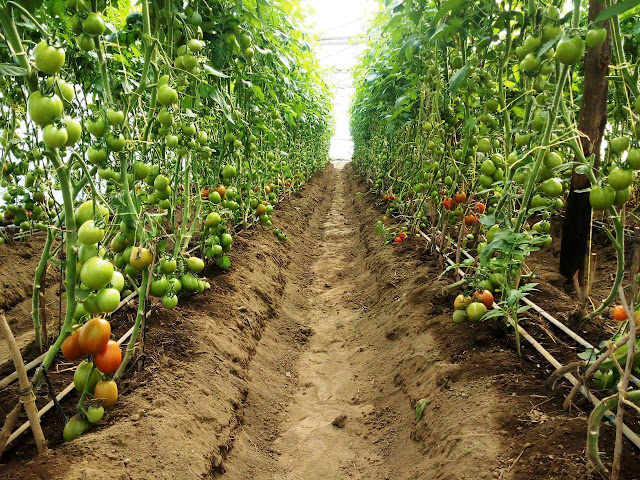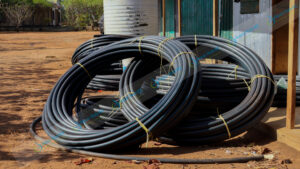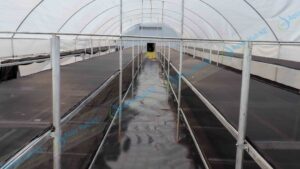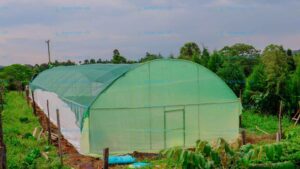Tomato farming in Kenya is among the crop ventures with high yield and profitability when done right. With climate change affecting agriculture in Kenya, farmers need to implement drip irrigation and greenhouse cultivation. These sustainable methods enhance the right moisture, temperature and nutrient rates thus leading to quality and high yields.
If you want to venture into Tomato farming in Kenya, Aqua Hub Kenya provides quality tomato drip kits and greenhouses at affordable cost. We ensure you have a reliable growing environment to enhance quality and high yield of tomato. Durable greenhouses, reliable drip kits and leads to best hybrid tomato varieties.
Call 0790719020
How Profitable is tomato Farming in Kenya?
Yield Potential: Under optimal conditions and good management, an acre of tomatoes can produce over 15 tons. Average yields in Kenya typically range from 8 to 10 tons per acre, but with greenhouse farming, it can reach 20 tons per acre.
Market Prices: Tomato prices in Kenya fluctuate but generally range from KES 30 to KES 80 per kilogram, influenced by demand and quality. During peak seasons, prices can soar to KES 60-70 per kilogram.
Revenue and Profit: If you achieve a yield of 15 tons (15,000 kg) per acre and sell at an average farm price of KES 60 per kg, your revenue would be KES 900,000.
If your total production costs are, let’s say, KES 150,000, your net profit could be KES 750,000 per acre.
Conditions for Tomato Farming in Kenya
- Climate and Temperature: Tomatoes thrive in warm conditions. Optimum temperatures ranges from 20∘C to 27∘C. In cold regions, greenhouse farming meets these temperatures.
- Rainfall: An annual rainfall of 600mm to 1200mm is ideal for tomato cultivation. However, excessive rain causes fungal infections and affect fruit ripening. Irrigation is essential for proper control.
- Sunlight: Tomatoes are sun-loving plants, requiring a minimum of 6-8 hours of direct sunlight daily for optimal flowering and fruit development.
- Soil Requirements: perform best in well-drained, loamy soils rich in organic matter. The ideal soil pH for tomatoes is between 5.5 and 7.0.
- Before planting, it’s crucial to conduct a soil analysis to determine nutrient levels and pH, allowing for appropriate amendments. Deep plowing (40-60cm) is recommended to allow the fibrous root system to spread effectively.
- Altitude: Tomatoes generally grow well in altitudes ranging from 0 to 2000 meters above sea level.
Why Venture into Tomato Farming in Kenya?
Firstly, unwavering demand for tomatoes in Kenya is the main reason why you should opt for its cultivation. Tomatoes are a culinary cornerstone, used to prepare a variety of stews, sauces, and salads. From humble kitchens to high-end restaurants, the demand for fresh tomatoes is constant and insatiable. This consistent market provides a reliable outlet for farmers’ produce.
Secondly, the short maturity period of most tomato varieties is a significant draw. Many varieties mature within 2-3 months, allowing farmers to achieve quicker returns on their investment.
Furthermore, tomatoes offer multiple growing seasons in many parts of Kenya, especially with proper irrigation. Year-round production allows for a more stable income generation and utilization of land.
Good market prices, particularly during off-peak seasons, also contribute significantly to profitability. While prices can fluctuate, strategic timing to harvest during periods of low supply can fetch high prices, substantially boosting farmers’ earnings.
Lastly, the focus on value addition is opening new avenues. Farmers are exploring processing tomatoes into paste, sauces, and dried forms, which have longer shelf lives and can command better prices, especially when fresh market prices are low. This not only reduces post-harvest losses but also diversifies income streams
What is the Cost of Tomato Farming in Kenya?
The cost of tomato farming in Kenya depends on farm size, growing method (open field or greenhouse), labor, irrigation and fertilizer cost.
- Land Preparation: plowing, harrowing, and seedbed preparation may cost around KES 15,000 to KES 20,000 per acre.
- Seedling Costs: High-quality, certified tomato seedlings are ideal. from KES 8,000 to KES 15,000 per acre,
- Labor Costs: Tomato farming is labor-intensive. Costs for planting, weeding, staking, pruning, and harvesting can range from KES 10,000 to KES 20,000 per acre.
- Irrigation Costs: reliable irrigation is vital for consistent yields, especially during dry spells. Drip irrigation is the best method to use. Drip kits and setup cost are between KES 130,000 – KES 180,000.
- Fertilizers: To ensure quality and healthy tomatoes, invest in fertilizers of KES 15,000 – KES 30,000.
- Pesticides: for controlling pests such as aphids, whiteflies and fungal infections, you need to buy pesticides. around KES 5,000 – KES 10,000.
- Miscellaneous Costs: transportation of produce, packaging, and export costs, which can add up to KES 10,000 to KES 20,000 per acre.
Propagation of Tomato seedlings
Seed Selection
Purchase high-quality, certified seeds from reputable suppliers to ensure good germination rates and disease resistance.
Seed Soaking
Soak tomato seeds for about 24 hours before planting can improve germination rates.
Sowing Seeds
tomato seeds can be raised in nursery beds or seedling trays.
- Nursery Beds Prepare a raised seedbed, about 15cm high, with well-tilled soil. Sow seeds in rows 2-3 cm apart, covering lightly with soil.
- Trays: For better control and reduced transplant shock, sow seeds in trays with a good seed-starting mix.
Germination and Seedling Care
Ensure adequate light for strong seedling growth. Water regularly, keeping the soil moist but not waterlogged. Reduce watering frequency a week or two before transplanting the seedlings, to make them more resilient.
Transplanting
Seedlings are typically ready for transplanting after one month or when they develop 4-6 leaves. Follow the steps below when transplanting tomato seedlings.
- Dig planting holes 15-20 cm deep, spacing them 60-90 cm apart depending on the variety.
- Gently remove seedlings with a ball of soil, ensuring the roots are not damaged. Plant them in the prepared holes, ensuring the first real leaves are 5-10 cm above the surface.
- Press the soil around the base of the plant and water immediately.
How to Water Tomatoes
Water is the most critical factor for tomato growth and fruit quality. Consistent and adequate moisture is non-negotiable.
- Frequency and Depth: Water deeply and thoroughly at the root zone for proper root growth and low water stress. Tomatoes need about 1-1.2 inches of water and 3-4 irrigation times per week.
- Timing: The best time to water tomatoes is early in the morning. This allows the foliage to dry before nightfall, reducing the risk of fungal diseases. Avoid overhead sprinklers as foliar wetting can encourage diseases and fruit rot.
Best irrigation method for tomato farming in Kenya
Drip Irrigation is an efficient method for watering tomatoes and other high value crops.
It delivers water directly to the root zone, minimizing water wastage through evaporation and runoff. It also keeps the foliage dry, significantly reducing the incidence of leaf diseases. While the initial setup cost can be higher, it pays off in water conservation and improved plant health.
Practices for High Yield in Tomato farming
Achieving a high yield in tomato farming requires diligent care and adherence to best practices:
- Variety Selection: Choosing the right tomato variety is crucial. Consider factors like disease resistance, yield potential, maturity period, and market demand. Popular varieties in Kenya include Rio Grande (good for processing and fresh market), Anna F1 (high-yielding hybrid, bacterial wilt tolerant), Tylka F1 (large fruits, very productive), and Kilele F1 (high disease resistance, long shelf life). Determinate varieties are bushier and fruit all at once, while indeterminate varieties continue to grow and produce throughout the season, ideal for extended harvests.
- Nursery Management: Start healthy seedlings in a well-prepared nursery bed or trays. Ensure proper spacing, adequate light, and consistent moisture. Hardening off seedlings by gradually reducing water a week before transplanting prepares them for field conditions.
- Soil Preparation and Nutrients: well-drained, fertile soil is key. Apply manure or compost to improve soil structure and fertility. Based on soil test results, apply balanced fertilizers rich in phosphorus and potassium during planting. Avoid excessive nitrogen after flower set, as it promotes foliage growth over fruit production. Calcium is essential to prevent blossoms end rot.
- Spacing: Proper spacing prevents overcrowding, which improves air circulation, reduces disease spread, and allows plants to access sufficient nutrients and sunlight. Leave at least 1.5-2 feet between determinate varieties and 2-3 feet for indeterminate varieties.
- Staking and Pruning: This is vital for indeterminate varieties and beneficial for determinate ones. Staking provides support as the plants grow tall and heavy with fruit, preventing them from sprawling on the ground, which can lead to disease and fruit rot. Pruning involves removing suckers (side shoots), old leaves, and diseased leaves to direct the plant’s energy towards fruit production and improve air circulation. This should be done weekly.
- Weed Control: Weeds compete with tomato plants for nutrients, water, and sunlight, significantly impacting yields. Implement effective weed control strategies from the outset.
- Pest and Disease Management: Regular scouting for pests and diseases is essential for early detection and intervention. Integrated Pest Management (IPM) strategies, combining cultural, biological, and chemical methods, are most effective.
Weed Control in Tomato Farming in Kenya
Crop Rotation: Rotating tomatoes with non-solanaceous crops such as legumes disrupts weed life cycles and reduces their build-up in the soil.
Mulching: Organic mulches suppress weed growth by blocking sunlight and inhibiting germination.
Plastic Mulching films: covers the soil spaces between tomato plant lines and prevents weed growth.
Hand Weeding: Labor-intensive but effective, especially for small-scale farming, as it removes weeds from the root.
Chemical Weed Control: Herbicides can be used, but extreme care must be taken to choose the right type. apply it correctly to avoid harming the tomato plants and the environment. Always follow manufacturer instructions.





